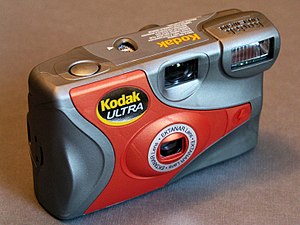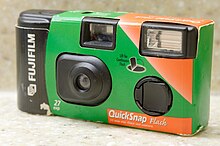Disposable camera
This article'stone or style may not reflect theencyclopedic toneused on Wikipedia.(September 2023) |

Adisposableorsingle-use camerais a simplebox camerameant to be used once. Most usefixed-focus lenses.Some are equipped with an integratedflashunit, and there are even waterproof versions forunderwater photography.Internally, the cameras use a135 filmor anAPScartridge.
While somedisposablescontain an actual cartridge as used for loading normal, reusable cameras,[1]others just have the film wound internally on an open spool. The whole camera is handed in for processing. Some of the cameras arerecycled,i.e. refilled with film and resold. The cameras are returned for "processing" in the same fashion as film cameras.
In general the one-time-use camera represents a return to the business model pioneered byKodakfor their Kodak camera, predecessor to theBrowniecamera; it is particularly popular in situations where a reusable camera would be easily stolen or damaged, when one's regular camera is forgotten, or if one cannot afford a regular camera.
History
[edit]
A company called Photo-Pac produced a cardboard camera beginning in 1949 which shot eight exposures and which was mailed-in for processing. Cameras were expensive, and would often have been left safely at home when photo opportunities presented themselves. Frustrated with missing photo opportunities, H. M. Stiles had invented a way to enclose 35mm film in an inexpensive enclosure without the expensive precision film transport mechanism. It costUS$1.29(equivalent to $16.52 in 2023). Though incredibly similar to the familiar single-use cameras today, Photo-Pac failed to make a permanent impression on the market.[2]
In 1966, French company FEX introduced a disposablebakelitecamera called "Photo Pack Matic", featuring 12 photos (4×4 cm).[3]
The currently familiar disposable camera was developed byFujifilmin 1986. Their QuickSnap line, known as tả ルンです (Utsurun-Desu,"It takes pictures"[4]) in Japan, used35 mm film,while Eastman Kodak's 1987 Fling was based on110 film.[5]Kodak released a 35 mm version in 1988,[6]and in 1989 renamed the 35 mm version the FunSaver and discontinued the 110 Fling.[7]
Common uses
[edit]Disposable cameras are popular with tourists and people traveling around the world to save pictures of their adventures.
Since the late 1990s, disposable cameras have become increasingly popular aswedding favors.Usually they are placed on tables at wedding receptions to be used by guests to capture their unique perspective of the event. More commonly they are available in colors to match the wedding theme such as ivory, blue, white, gold, etc.[8]
So-called "accident camera kits" containing film-based disposable cameras[9][10]are increasingly being carried in vehicles to take images asevidenceafter anaccident.[11]The absence of batteries allows instantaneous usage even after extended storage, for example in a glove compartment.
They often have cheap plastic lenses, below average film quality, and fixed focal lengths. The quick ease of the 'point and shoot' method that these disposable cameras were made for make them popular with many photographers who enjoy the 'less than perfect' style these cameras provide, in a move away from digital imagery,[12]which can also be seen in the rise in popularity of 'lomography'. This has also led to a number of 'lost art' type projects where disposable cameras are left in public spaces with a message for anyone finding the camera to take some images and then post the camera back, or pass it on to another person.[13]The low cost of the cameras makes them a perfect tool for these sorts of projects.[14]
Digital
[edit]Digital one-time-use cameras (and also digital one-time-use camcorders) are available in some markets; for example the US saw the introduction of one such digital camera in 2004.[15]Digital disposables have not had the success of their film based counterparts, possibly from the expense of the process (especially compared to normaldigital camerause) and the poor quality of the images compared to either a typical digital camera, or a disposable film camera. Usually, the display shows the number of shots remaining, and once this is completed, the camera is returned to the store. The digital files are then extracted from the camera, and in return for keeping the camera, they are printed out or stored to CD (or DVD in the case of the video camera[16]) for the customer. Almost all digital 'single use' cameras have been successfullyhacked[17]to eliminate the need to return them to the store. The motivations for such hacking include saving money and, more commonly, the challenge of overcoming artificial impositions (such as a 25 shot limit on an internal memory that can store 100 images).
Other uses
[edit]The high-voltage photo flash capacitors in some cameras are sometimes extracted and used to power devices such ascoil guns,[18]stun guns, homemadeGeiger counterprojects[19]and "RFID zapper"EMPdevices.[20]
See also
[edit]References
[edit]- ^"Ferrania Dual Cassette System".Ferrania Technologies.Archived fromthe originalon 2006-10-23.Retrieved2006-11-17.
- ^"The First Disposable Camera".Modern Mechanix.September 1949.ISSN0025-6587.Archived fromthe originalon 2011-09-27.Retrieved2008-11-25.
- ^Halgand, Sylvain (14 February 2014)."Fex Indo Photo-Pack Matic".www.collection-appareils.fr(in French).Archivedfrom the original on 4 March 2016.Retrieved23 September2022.
- ^"Throw-Away Cameras Gain A Loyal Following in Japan".The New York Times.1993-01-01.Retrieved2007-12-27.
- ^"Kodak: History of Kodak: Milestones 1980 - 1989".Archived fromthe originalon 2007-11-11.Retrieved2007-12-27.
- ^Grundberg, Andy (1988-03-20)."CAMERA; This Newcomer Is Disposable".The New York Times.Retrieved2007-12-27.
- ^"KODAK: History of KODAK Cameras: Tech Pub AA-13".Archived fromthe originalon 2007-11-14.Retrieved2007-12-27.
- ^"DISPOSABLE CAMERAS — VARIOUS-COLOURS".Archived fromthe originalon 2015-05-08.Retrieved2007-03-05.
- ^"Accident Camera Kit".Archived fromthe originalon 2007-02-19.Retrieved2007-03-05.
- ^"Collision.kit".Archived fromthe originalon 2007-09-16.Retrieved2007-08-21.
- ^"Federal Consumer Action Center — Auto Insurance — Insurance Tips".Retrieved2007-08-21.
- ^"Discovering beauty with disposable cameras / Korea Times".Archivedfrom the original on 2012-02-04.Retrieved2009-09-13.
- ^"disposable memory project".Retrieved2009-09-12.
- ^"Lose your camera and watch it travel the world".Retrieved2009-09-12.
- ^Graham, Jefferson (2004-08-19)."A disposable digital camera enters the market at $19.99".USA Today.Retrieved2007-08-28.
- ^"CVS One-Time-Use Video Camcorder Review — CVS Camcorders".Camcorderinfo.com. 2005-06-27.Retrieved2009-10-09.
- ^"Pure Digital / CVS Disposable Digital Camcorder".Maushammer.com. 2005-06-13. Archived fromthe originalon 2011-07-14.Retrieved2009-10-09.
- ^"Disposable Camera Coilgun".
- ^"Yahoo! Groups".Archived fromthe originalon 2020-10-31.Retrieved2009-11-30.
- ^"RFID-Zapper(EN) - 22C3".events.ccc.de.
